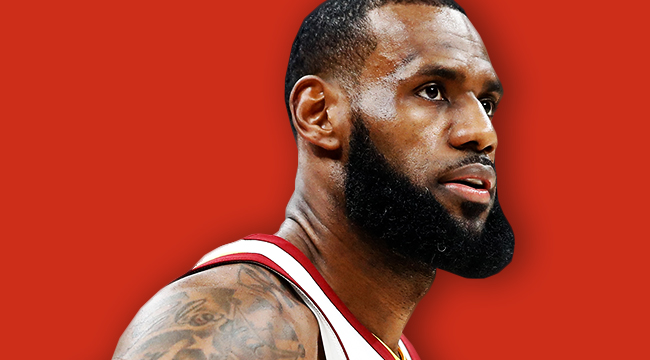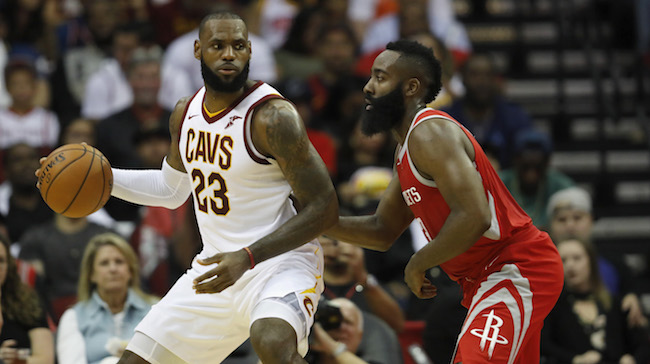
After a slow start to the season, the Cavaliers have gotten hot, winning 14 of their last 15 games to vault into third in the East, mere percentage points behind the Raptors for the two spot. LeBron James is playing some of the best basketball of his career (or the best if you believe ex-Cavs GM David Griffin) and appears to be happy with his current position with his good buddy Dwyane Wade along for the ride.
Despite the Cavs’ strong start and James becoming apparently happy and comfortable with this year’s version of the team, rumors and speculation about his impending free agency decision are heating up. The Lakers remain at the forefront of discussions when it comes to which team James could leave for, especially after he recently purchased a new home in the L.A. area. While the Lakers are hopeful they can pry James away from Cleveland, it’s clear they will have some stiff competition.
The top challenger to the Cavs for James’ services might not be the Lakers, but the Rockets, who have quickly emerged as one of the league’s best teams and have something few other teams have — one of James’ best friends. Chris Paul is a member of the famed Banana Boat crew, and with family being an ever-important aspect of LeBron’s life, having one of his closest friends alongside would certainly make a transition easier.
Aside from the CP3 connection, there are very real basketball reasons to go to Houston. With Paul and Harden, the Rockets’ offense has been dynamic, and the defense has been surprisingly strong. Houston balances having a ball-movement-focused attack with leaning on their dominant superstar in isolation in critical situations, and adding LeBron to that mix would only make them even more formidable and bring them neck and neck with the Warriors in the West.

The question is whether the Rockets can make it work financially. The first step in any LeBron-to-Houston scenario is to ship Ryan Anderson’s $20 million deal out of town for virtually nothing. There are very few teams capable of eating that contract, which still has $41.7 million remaining on it, but as The Ringer’s Jonathan Tjarks notes, the Kings seem like the best destination due to their combination of cap space and lack of their own 2019 draft pick that would prohibit them from trying to tank next year and thus not take on a veteran like Anderson.
With Anderson out of the picture, the Rockets would be at $60.01 million, giving them $41 million to work with under the projected salary cap of $101 million for next season. That is a large chunk of change; however, it vanishes very quickly when taking cap holds into account. Tim Cato of SB Nation offered a glimpse of what the Rockets’ cap situation will look like next summer, and things don’t look great for Houston’s chances of landing the King.
For the Rockets to keep the roster intact – and depth is among their selling points for being a top contender, so that would be important – everyone would have to be on the same page. Cap holds, which will allow the Rockets to go over to sign Chris Paul, Trevor Ariza, Clint Capela, and others, will make money very tight and require LeBron to take far less than he would make in Cleveland or Los Angeles — Paul’s cap hold alone will eat up almost all of their space created by an Anderson trade.
According to Cato, Paul’s cap hold will be around $39 million, while Ariza ($12.8 million) and Capela ($5.8 million) chew up almost another $19 million. Eric Gordon and James Harden make a combined $43.9 million next season, and P.J. Tucker, whose defense has been critical to their defensive turnaround and versatility on the wing, makes another $8 million next season. If the cap lands at $101 million as projected and they magically are able to trade away everyone else on the roster under contract other than Harden, Gordon and Tucker, that would leave them with approximately $49 million in cap space. That vanishes immediately with the holds on Paul, Capela, and the Rockets’ $4-plus million in roster charges (per Cato).
So to make this work in free agency, LeBron and CP3 have to be willing to sacrifice nearly half of what they could make on a max deal, and both take about $19.5 million each (still a lot of money, but not nearly as much as they could make). That would let Houston retain Capela by going over the cap with his Bird Rights and have a core group of Paul, Harden, Tucker, James, Capela, and Gordon. That’s a very good six-man rotation, almost as good as there is in the NBA, but it strips Houston of their depth as they’d be left to fill in the gaps with exceptions and minimum contracts, which somewhat defeats the purpose of LeBron leaving.
The only other options, as Cato notes, are to get rid of Tucker and Gordon or Capela to create more space but strip away any and all depth, or find a way to work a trade either this season, in which James opts into his option and Paul re-signs this summer, or work a sign-and-trade this summer.
The former almost assuredly won’t happen, as LeBron would have to literally force his way out of Cleveland. James has worked incredibly hard to repair his image back home, and while the fans could accept him leaving next summer, they would not be so accepting of him bailing midseason when the Cavs remain a favorite to win the East. That leaves the sign-and-trade route, which isn’t impossible, but again would strip away a lot of the depth in Houston and require the Cavs to take on Ryan Anderson’s deal.
The short version of this is, LeBron is all but assuredly not going to Houston. That said, if Daryl Morey can make it work, the NBA will need to rename their Executive of the Year award after him because it will be one of, if not the, best GM jobs in creating cap space and manipulating the cap in history.






